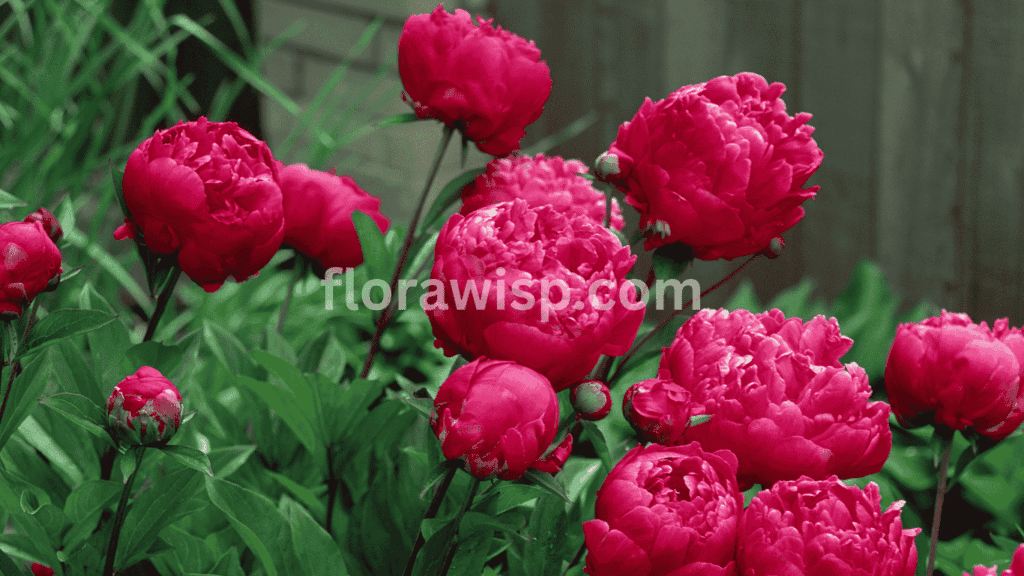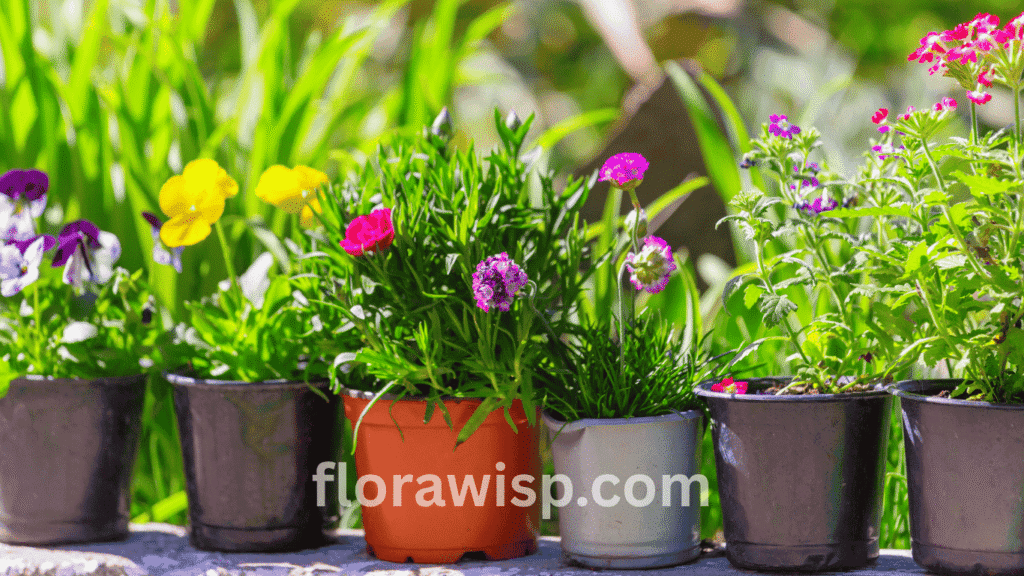There’s a timeless charm to watching a red peony burst into bloom under the early summer sun. As someone who has cultivated these treasures in American gardens for over decades, I can tell you they’re more than just flowers, they’re living symbols of romance, prosperity, and enduring beauty. Across cultures, red peonies have carried meaning for centuries: in China, they’re honored as the “King of Flowers,” while in the West, they’ve graced wedding bouquets and garden borders as emblems of love and celebration.
From the velvety petals of a deep red peony to the dramatic tones of dark red peonies, each variety offers its own personality and elegance. Once established, a well-cared-for peony red plant can live for decades, producing bigger, richer blooms year after year. Whether you’re looking to enhance your garden, attract pollinators, or create breathtaking floral arrangements, peony flower promise beauty, resilience, and a touch of timeless sophistication in every petal.
We,ll Explore
Popular Red Peony Varieties for Your Garden
Over the years, I’ve trialed more than 15 different red peony varieties, but these six remain my all-time favorites. Each brings its own charm, from the fiery scarlets to the deep velvety crimsons, and they all thrive beautifully in temperate gardens with cold winters.
1. Red Charm Peony
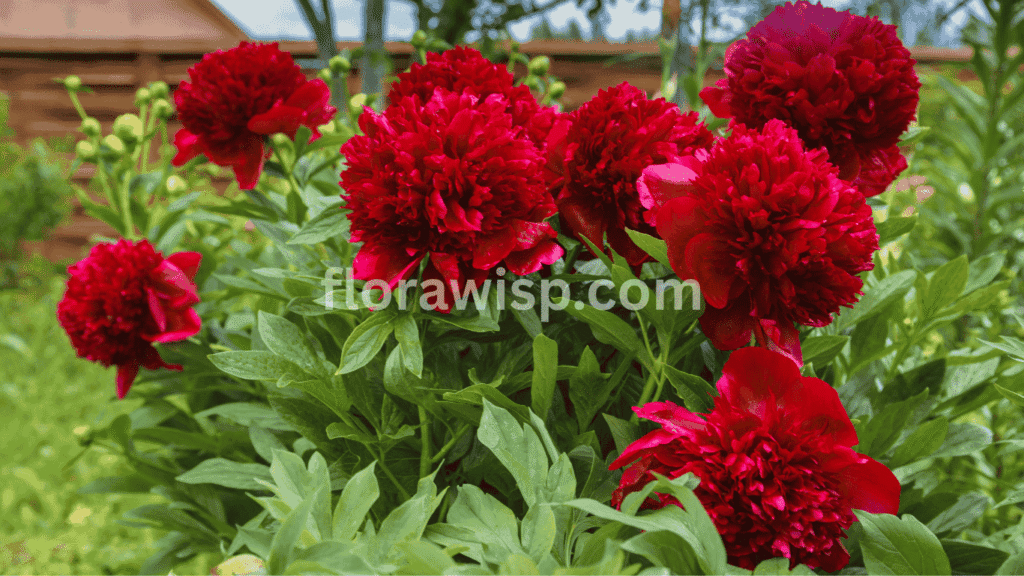
The Red Charm Peony is the showstopper of my spring garden. Its deep crimson, fully double blooms look like velvet pom-poms, each reaching up to 8 inches across. The light, sweet fragrance drifts across my yard in late May, making it a seasonal highlight. I’ve found that planting it in full sun with well-draining soil, plus a dose of slow-release fertilizer in early spring, ensures those enormous blooms return year after year.
Quick Reference:
- Scientific Name: Paeonia lactiflora ‘Red Charm’
- USDA Zone: 3–8
- Bloom Time: Late Spring
- Mature Size: 2–3 ft tall × 2–3 ft wide
- Light Needs: Full Sun
- Soil Preference: Well-drained, fertile, neutral to slightly acidic
2. Red Magic Peony
If you want a variety that commands attention from across the yard, the Red Magic Peony is the one. Its petals have a fiery scarlet glow that stands out in borders and garden beds. I often cut these blooms for indoor arrangements; they last up to 7 days in a vase, holding their shape and color beautifully.
Quick Reference:
- Scientific Name: Paeonia lactiflora ‘Red Magic’
- USDA Zone: 3–8
- Bloom Time: Mid to Late Spring
- Mature Size: 3 ft tall × 3 ft wide
- Light Needs: Full Sun
- Soil Preference: Rich, well-drained, slightly acidic
3. Kansas Red Peony
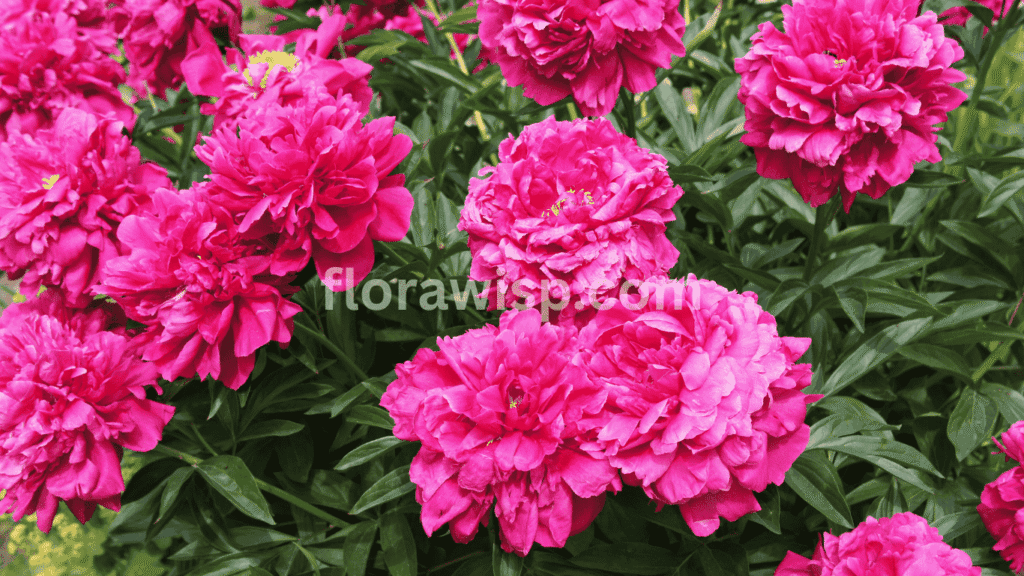
The Kansas Red Peony has been a workhorse in my garden for years. Hardy even to Zone 3, it shrugs off late frosts without a scratch. The fully double flowers are vibrant and full-bodied perfect for lining pathways or creating bold focal points in mixed borders.
Quick Reference:
- Scientific Name: Paeonia lactiflora ‘Kansas’
- USDA Zone: 3–8
- Bloom Time: Late Spring
- Mature Size: 2–3 ft tall × 2–3 ft wide
- Light Needs: Full Sun
- Soil Preference: Moist, well-drained, slightly acidic
4. Red Sarah Bernhardt Peony
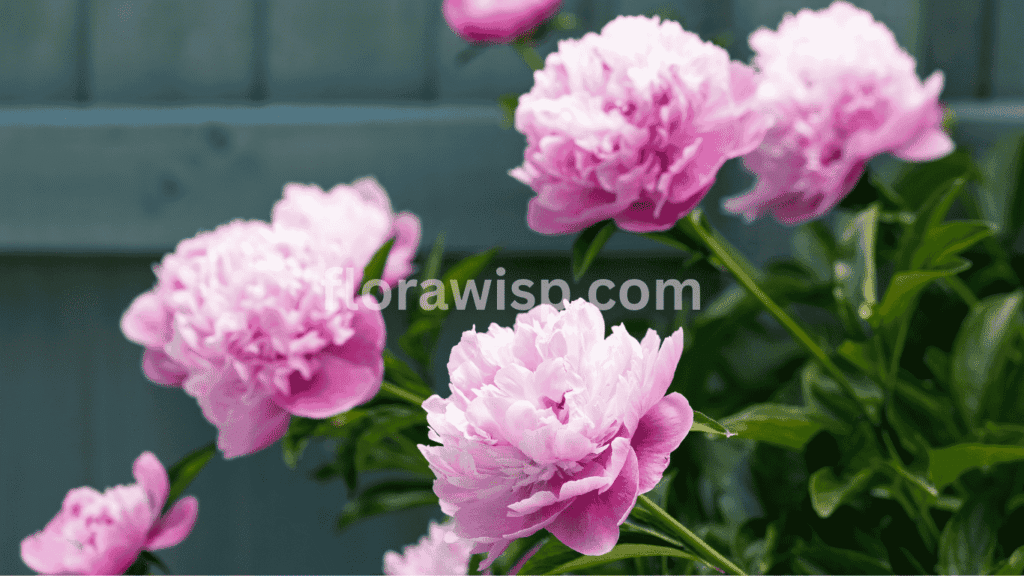
A romantic twist on the beloved classic, the Red Sarah Bernhardt Peony boasts wine-red petals with softly ruffled edges. I love pairing it with blush or cream varieties for a layered, painterly effect in my garden beds.
Quick Reference:
- Scientific Name: Paeonia lactiflora ‘Red Sarah Bernhardt’
- USDA Zone: 3–8
- Bloom Time: Late Spring
- Mature Size: 3 ft tall × 3 ft wide
- Light Needs: Full Sun to Partial Shade
- Soil Preference: Fertile, well-drained, neutral to slightly acidic
5. Itoh Peony Red
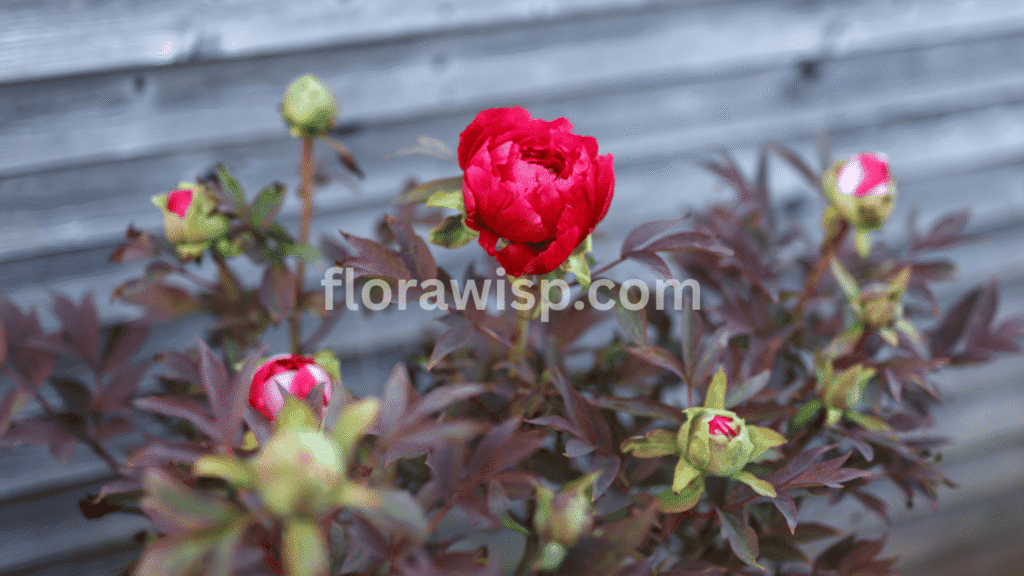
The Itoh Peony Red is a hybrid marvel combining the hardiness of tree peonies with the prolific blooms of herbaceous ones. Its blossoms can last up to 3 weeks in cooler temperatures, and its sturdy stems stand tall even after heavy rain.
Quick Reference:
- Scientific Name: Paeonia Itoh hybrid ‘Red’
- USDA Zone: 4–9
- Bloom Time: Late Spring to Early Summer
- Mature Size: 2–3 ft tall × 3–4 ft wide
- Light Needs: Full Sun to Partial Shade
- Soil Preference: Well-drained, fertile, slightly acidic
6. Karl Rosenfield Red Peony
If you’re after drama, the Karl Rosenfield Red Peony delivers. Its large, semi-double ruby-red blooms open in early summer and hold their bold color even in bright sunlight. In my garden, it’s a centerpiece plant that always draws compliments.
Quick Reference:
- Scientific Name: Paeonia lactiflora ‘Karl Rosenfield’
- USDA Zone: 3–8
- Bloom Time: Early to Mid-Summer
- Mature Size: 2–3 ft tall × 2–3 ft wide
- Light Needs: Full Sun
- Soil Preference: Rich, moist, well-drained
Tip from Experience:
All of these red peonies flourish best with at least 6 hours of direct sunlight daily and benefit from the winter chill period of 500–1,000 hours below 40°F. Plant them with crowns 2 inches below the soil surface for optimal flowering.
Spotlight on the Red Charm Peony
Among all the red peonies I’ve grown in my years of gardening, the Red Charm Peony stands as the crown jewel. Its immense, bomb-shaped double blooms burst open in late spring, revealing a deep, velvety crimson that glows in the sunlight. Each flower can reach up to 8 inches across, with layers of tightly packed petals that seem to last forever in the garden. The moment they bloom, visitors in my yard always stop to ask what variety they are.
Growing Conditions for Healthy Blooms
From my experience, Red Charm Peonies thrive in well-drained soil enriched with compost or aged manure. They prefer full sun for at least 6 hours a day, though in hotter regions, a touch of afternoon shade can help protect the blooms from fading. Just like when you’re growing peonies, plant them with their crown no deeper than 2 inches below the surface; planting too deep often delays flowering.
Water them deeply once a week during dry spells, focusing at the base to keep foliage dry and prevent fungal issues. In early spring, I apply a slow-release fertilizer high in phosphorus to encourage abundant blooms.
Cut Flower Favorite
One of the reasons I always keep a few extra red charm peonies in my cutting bed is their exceptional vase life. Harvest them when the buds feel soft like a marshmallow and you can enjoy them indoors for up to 10 days. Their sturdy stems and vibrant color make them a florist’s dream for wedding bouquets and event arrangements.
Quick Reference
- Scientific Name: Paeonia lactiflora ‘Red Charm’
- Plant Type: Herbaceous perennial
- USDA Planting Zones: 3–8
- Mature Size: 24–36 inches tall, 18–24 inches wide
- Bloom Time: Late spring to early summer
- Fragrance: Light, sweet scent
If you ever spot red charm peonies for sale at a nursery or reputable online shop, I recommend acting quickly as they sell out every season, and for good reason.
Rare and Unique Red Peony Types
While the classics get much of the attention, some red peony varieties are true collector’s treasures, worthy of any dedicated gardener’s wish list. Over the years, I’ve sought out and grown these rarities, and they’ve rewarded me with unforgettable displays that turn my spring garden into a living gallery.
Double Red Peony: A Blooming Masterpiece
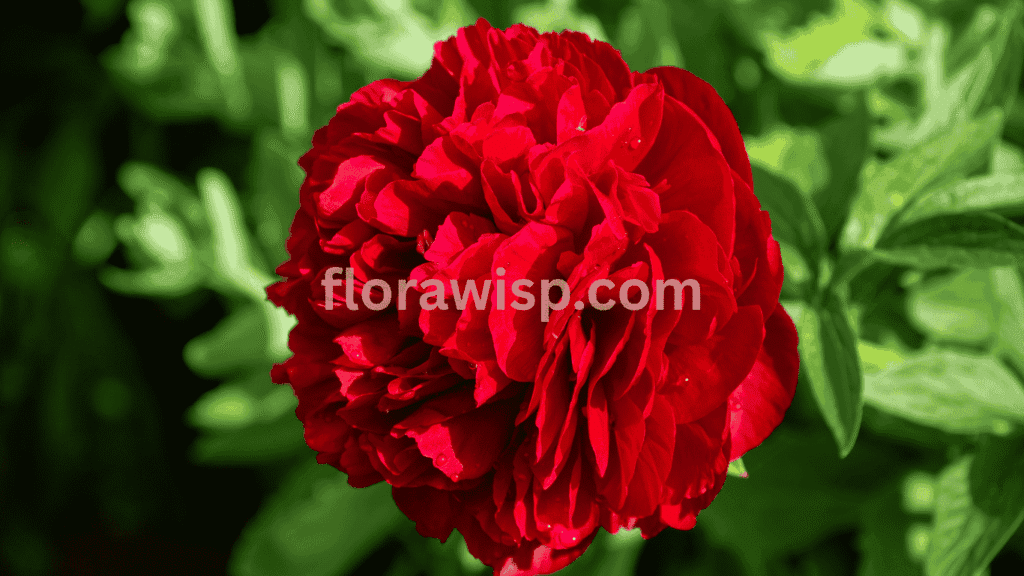
My double red peony plant has been a reliable showpiece. These blooms can reach the size of dinner plates, layered with tightly packed petals that create an opulent, almost ruffled texture. Their depth of crimson intensifies as they age, making each bloom a little different from the last. In my experience, they perform best in fertile, well-draining soil with at least 6 hours of direct sun.
Quick Facts:
Scientific Name: Paeonia lactiflora (double cultivars)
USDA Zones: 3–8
Bloom Time: Late spring
Fragrance: Light, sweet
Red Tree Peony: Long-Lived Elegance
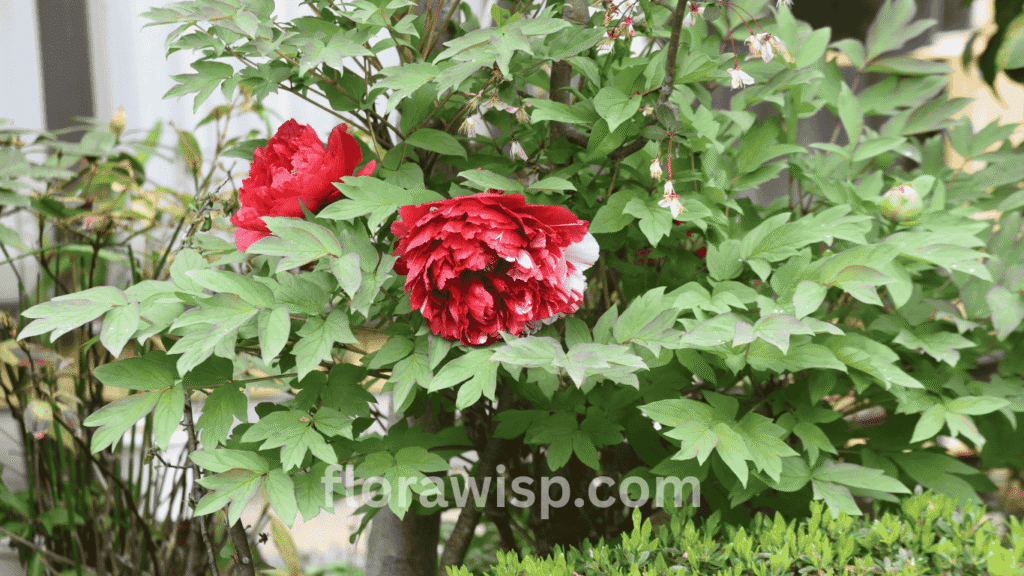
If you want a red peony that will outlast generations, the red tree peony is your answer. With woody stems, it blooms earlier than herbaceous types, often a full two weeks ahead in my garden. These plants can live for decades, producing blooms in shades ranging from ruby to deep garnet. I’ve found they appreciate afternoon shade in hotter regions and benefit from a top-dressing of compost each spring.
Quick Facts:
Scientific Name: Paeonia suffruticosa
USDA Zones: 4–9
Bloom Time: Mid-spring
Fragrance: Moderate to strong
Red and White Peonies: A Striking Contrast
For gardeners looking to add a playful twist, red and white peonies bring a unique bicolor surprise. Their petals may be streaked, tipped, or fully variegated, making them stand out even among the most colorful beds. They require a bit more attention. I keep a closer eye on soil moisture and disease prevention but the results are worth every extra step.
Quick Facts:
Scientific Name: Paeonia lactiflora (variegated cultivars)
USDA Zones: 3–8
Bloom Time: Late spring
Fragrance: Light
Growing & Caring for Red Peonies
A healthy red peony plant begins with the right start. I’ve planted dozens over the years, and without fail, those set in the right spot and depth reward me with more blooms each season.
Planting for Success
The ideal time to plant is early fall or early spring. Place the crown no deeper than 2 inches below the soil surface; planting deeper often delays flowering. Choose a location with full sun and good air circulation to help keep foliage dry and prevent disease.
Quick Tip: If your garden is prone to strong winds, plant near a fence or hedge for some protection without blocking sunlight.
Seasonal Care and Fertilization

Every winter, I mulch my red peony bush with shredded leaves or straw to protect roots from extreme temperature swings. Always keep mulch a few inches away from the crown to prevent rot. In early spring, I feed with a low-nitrogen fertilizer, which encourages lush blooms instead of excessive foliage.
Watering & Stem Support
The red peony flower thrives with deep, infrequent watering about once a week in dry conditions. This encourages strong root growth. When a peony red stem bends under the weight of a heavy bloom, I use discreet hoop supports to keep flowers upright without spoiling their natural look.
By following these steps, your red peony blooms will not only be abundant but also long-lasting, turning your garden into a seasonal showcase year after year.
Troubleshooting Common Red Peony Issues
Even the healthiest red peony plants can encounter a few challenges over the years. Knowing how to spot and address problems early has saved many of my plants from decline.
Peony Leaves Turning Red: What It Means
If you notice peony leaves turning red in midsummer, it’s often a sign of natural aging as the plant shifts energy back to its roots. However, if the leaves start turning red or purple in early summer, it may point to nutrient deficiencies particularly phosphorus or potassium or early fungal infections. I recommend testing your soil every few years and applying a balanced, slow-release fertilizer if needed.
Weak or Floppy Red Peony Stems
A peony red stem that bends or grows weakly is often the result of overcrowding or insufficient sunlight. In my garden, I divide mature peony clumps every 8–10 years to improve airflow and allow each stem to develop strength. If sunlight is limited, consider relocating the plant to a sunnier spot with at least six hours of direct light daily.
Pests and Diseases
While ants on blooms are harmless they’re simply drawn to the nectar they can indicate the presence of aphids, which need prompt control. I spray a gentle mix of water and mild insecticidal soap when infestations appear. Peony pests like thrips can damage petals, so I inspect buds in early spring and treat them before blooming begins.
Common peony diseases:
Include botrytis blight, which thrives in cool, damp conditions. The best prevention is good sanitation:
- Remove and dispose of spent blooms and foliage promptly.
- Space plants at least 3 feet apart for airflow.
- Water at the base rather than overhead to keep leaves dry.
Red Peonies in Floral Design
Few flowers make a statement in arrangements quite like the red peony. Whether it’s for a wedding, celebration, or just to brighten a dining table, the lush texture and rich color of these blooms make them a florist’s favorite.
Red Peony Bouquet

A red peony bouquet embodies timeless elegance. I’ve created arrangements for weddings where the velvety blooms were paired with dusty eucalyptus for a soft, romantic feel. For brides seeking something unforgettable, a red peony bridal bouquet can stand alone or mix beautifully with complementary flowers.
Dramatic Color Pairings
If you want to create a bold visual contrast, a dark red peonies bouquet mixed with soft pink peonies is stunning. In some of my favorite event designs, I’ve paired pink peonies and red roses, and the interplay of textures and colors turned heads every time. These combinations work equally well for table centerpieces, adding depth and richness to the display.
Tips for Longer-Lasting Blooms
For maximum vase life, I always cut peonies when they’re in the “marshmallow” bud stage firm but slightly soft to the touch. Keep stems in cool water, change the water daily, and trim stems every two days. In a cool room, a red peony flower can last up to a week indoors, allowing you to enjoy their beauty long after they’re cut.
Where to Buy Red Peonies and Plant Material
Finding quality red peonies for sale is more than just browsing through a catalog; it’s about ensuring you’re getting strong, healthy plants that will thrive for years. Over the years, I’ve learned that the best blooms often come from reputable nurseries or growers who specialize in peonies.
Choosing the Best Red Peony Plants
When browsing red peony plants for sale, look for large, firm root divisions with at least 3–5 visible “eyes” or buds. These eyes are where next year’s stems and flowers will emerge. Avoid roots that feel soft or shriveled, as they may struggle to establish.
Buying Online and Ensuring Safe Delivery
Ordering online is a convenient way to access rare varieties, but I always make sure the supplier has a reputation for quality. If you’re having red peonies delivered, look for vendors that use insulated or padded packaging to protect roots during transit. Timely shipping is crucial, especially in extreme weather, to prevent damage.
Many top growers also offer planting guides, which can be a bonus for gardeners looking to ensure their red peony plant gets the best start possible.
Symbolism and Meaning of Red Peonies
Beyond their garden beauty, the red peony carries a rich history and deep cultural symbolism that makes it a meaningful flower in many traditions.
Cultural Significance Across the World
The red peony symbolizes wealth, honor, and prosperity, and is often associated with high social status. During festivals, red peony flowers are displayed as a sign of good fortune and happiness.
In Western traditions, the red peony flower often represents romance, passion, and heartfelt devotion. They make a striking choice for anniversaries, weddings, or any occasion where love is the central theme.
A Flower with Emotional Impact
As a gardener, I’ve seen how the symbolism of red peonies resonates with people. When given as a gift, they carry more than beauty; they carry a message. Whether it’s the bold energy of a bridal bouquet or the thoughtful gesture of a single stem, the red peony brings depth to every arrangement.
This blend of beauty and meaning makes the red peony a perfect choice for both the garden and the vase, ensuring it remains one of the most cherished flowers worldwide.
Conclusion:
After years of growing red peony plants, I can say that they are among the most rewarding perennials any gardener can cultivate. Their lush, layered petals and rich tones make them an instant focal point in any landscape. With so many red peony varieties available, there’s truly a perfect match for every gardener’s style whether you prefer the deep, velvety shades of dark red peonies or the vibrant, fiery tones that brighten up spring borders.
Beyond their beauty, these blooms carry a sense of elegance and history, having graced gardens for centuries in both ornamental and symbolic roles. Their seasonal display is nothing short of breathtaking, rewarding you each year with bigger, fuller blooms as the plants mature. From cut flower arrangements to stunning garden backdrops, red peonies offer a timeless charm that’s hard to rival, making them an essential choice for gardeners who value both beauty and tradition.
FAQs
Q. How long do red peony blooms typically last?
Red peony blooms usually last 7–10 days, but with staggered planting of different varieties, you can enjoy blooms for 4–6 weeks. In my garden, early bloomers start in late May, with late varieties carrying color into July.
Q. Can red peonies grow in pots or containers?
Yes, red peonies can grow in pots if the container is at least 18 inches deep and wide. I’ve had success with container-grown plants in sunny patios, ensuring they get winter chill for bud formation.
Q. What’s the difference between red charm peony and red magic peony?
The Red Charm Peony has dense, bomb-shaped blooms, while the Red Magic Peony has looser petals and a slightly brighter hue. Both are excellent cut flowers, but Red Charm blooms slightly earlier.
Q. Do red peonies change color as they age?
Yes, some red peonies may fade to a softer shade as blooms mature. My Kansas Red Peonies, for example, open in rich crimson and mellow to a deep rose by week’s end.
Q. How many years does it take for a red peony to fully mature?
It usually takes 3–4 years for a red peony to reach peak blooming. The wait is worth it mature plants can produce dozens of large, showy flowers each season.
References
American Peony Society – Herbaceous Peonies
Wisconsin Horticulture Extension – Peony Guidance
Iowa State University Extension – Longevity of Perennials
Gardener, M.Sc. Horticulture
Elara Bennet is a gardening writer from Austin, TX, passionate about sustainable lawns and blooms. Read full bio →

